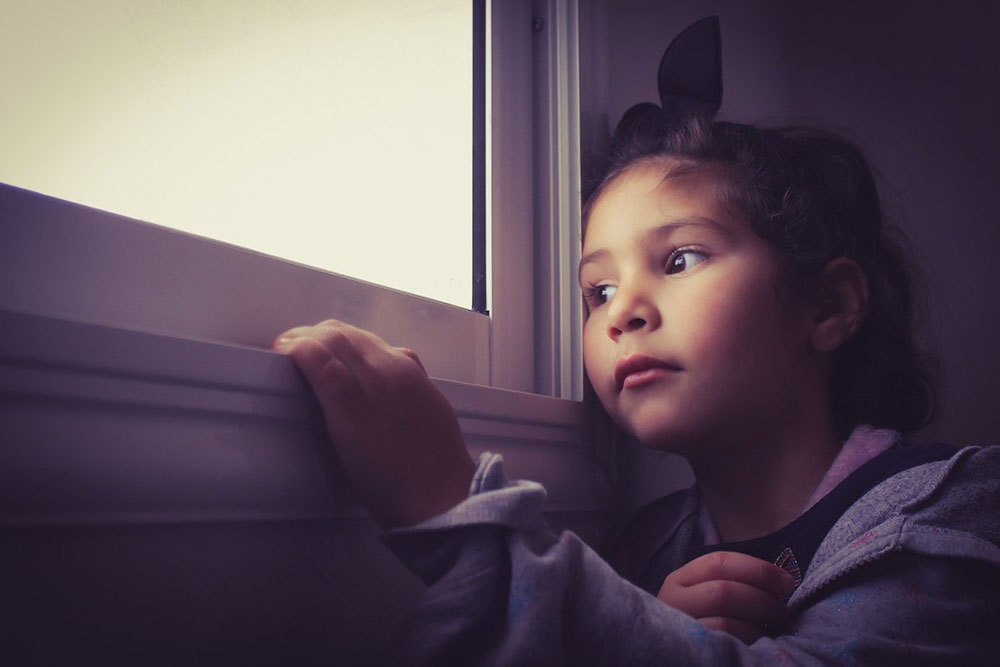10 Surprising Ways To Calm An Anxious Child
Published on March 5th, 2021
Updated on January 2nd, 2024

Children may show their anxiety in many different ways. Most of the time, they do not say, “hey Mommy, I am feeling anxious right now.” They usually show their anxiety through their behaviors. It may be tantrums, yelling, crying, acting silly, avoiding, or another behavior. They probably don’t even know why they are acting the way they are acting or what anxiety actually means.
Sometimes the automatic response to these behaviors is to tell them to CALM DOWN or punish the behavior. Neither of these reactions actually helps to calm the anxiety. There are ways to help calm an anxious child, even if they do not know they are anxious or why.
1. Connection
The first strategy to help calm an anxious child is to connect. Get down on the child’s level and offer eye contact, a hug, or just sit next to them. It is important to name what seems to be happening at the moment and offer your support. It seems like you may be feeling anxious (or whatever word you use to acknowledge the feelings of anxiety, such as nervous, stressed, upset, out of control), and I am here to help keep you safe.
Sponsored by

Choose a therapist to work with and start healing with 20% off from BetterHelp.
Click HereSome children prefer some space when they are anxious, and it may not be physically safe for you or them to be down on their level. Allow for space, but remind them you are there, and you will help keep them safe.
2. Chew Gum
If the child is old enough to chew gum, this is a good one to reduce anxiety. Chewing gum stimulates the vagus nerve, which is responsible for the body’s physical sensations that are felt when the fight/flight responses are activated, such as the feelings of the heart racing or stomach flipping. The vagus nerve also helps to calm and counteract those sensations. Chewing gum helps to stimulate that nerve to help calm the body.
If the child likes the bigger pieces of bubble gum or wants more than one piece, let them try that. That also adds tension and proprioceptive input to the jaw. Basically, the body uses the pressure from the chewing to help regulate the brain.
3. What-If Monster
The what-if monster is a powerful guy or girl! The what-if monster lives within all of us and sneaks up to the brain to feed on our worries. And he REALLY likes to eat worries! The worries are like candy for the monster… the more he has, the more he wants! And the rational thoughts are like vegetables, much better for him and fill him up faster so he won’t need to eat so much!
Talk with the child about what they are feeding the what-if monster. Some kids like to draw the monster or imagine where he lives in the body. Remember, the monster is not a bad thing! He just really likes worry candy, and he gets a little carried away sometimes!
4. Pushing
Pushing heavy objects has a similar response in the body as chewing gum. It puts pressure on the muscles and joints in the body, helping the body regulate, calm, and focus.
The child could push on your hands (let them push you backward but don’t make it too easy, you want them to work), push a laundry basket filled with books or toys, do pushups on the floor or walls, or pulling a wagon. You want them to be successful, but don’t make it too easy!
5. Sensory Activity
Some children do really well with tactile sensory activities. Things like clay, slime, sand, shaving cream, or small fidget toys can help them to calm, especially if they are anticipating a difficult situation like a doctor’s appointment.
Comfort objects may also be helpful. Soft blankets, favorite stuffed animals, or weighted blankets can all be helpful depending on the child.
6. Breath
When a child feels anxious, their breath is often shallow and rapid. This is the body’s way of preparing them to fight or run away. It also makes it difficult to calm the body!! Animal breathing is a fun activity to have kids focus on breathing. Have your child breathe like a horse: big slow breath in, then blow out like a horse raspberry. Then breathe like a sloth… really slow. Then have them pick an animal and breathe like them. Make sure it’s slow with a long exhale.
Blowing bubbles is also a fun way to slow down the breath!
7. Yoga
There are some fantastic yoga videos for kids on the internet! Animal yoga videos are a favorite of many children. Yoga helps the child focus their attention on the different parts of their body and stretch and move. Yoga incorporates deep breathing, as well. Once your child has done some yoga, find a favorite pose that you can prompt when anxiety creeps up in public.
8. Distract
I once worked with a very skilled practitioner who would say the most off the wall things when a child was dysregulated. She would come up with the funniest, goofiest, craziest comments, and she would just keep the story going. I watched the children look at her with utter confusion (as did I) and then start to engage in the story.
The distraction helped to change the course of the behaviors and engaged the child with the practitioner. They also thought it was hilarious, which made them laugh. Laughter helps to reduce stress hormones.
I recommend thinking of something goofy to say before the anxiety hits. It is stressful as a caregiver, too, and it can be hard to be creative in high-stress moments.
9. Jump and Move
Have your child move and jump. The more pressure on their feet, the better! Play follow the leader, or Simon says (with VERY simple instructions) to help them use their bodies and increase the proprioceptive input to help regulate their bodies.
Obstacle courses are a great way to do this, and they are super fun and distracting too!
10. Reflect
Once the child has calmed down, help them to reflect on the situation. What was helpful? What else did they need? What plan should you have for next time? Remind them they are safe, and you are there for them.
When kids struggle with anxiety, it can be heartbreaking, stressful, and frustrating to navigate. And though kids don’t usually tell you they are anxious, you can help them learn to manage their anxiety and label it so they can tell you. Hopefully, these strategies can help to make anxious situations more manageable.
Sponsored by

Find an affordable therapist online with 20% off from BetterHelp.
Click Here






Leave A Reply